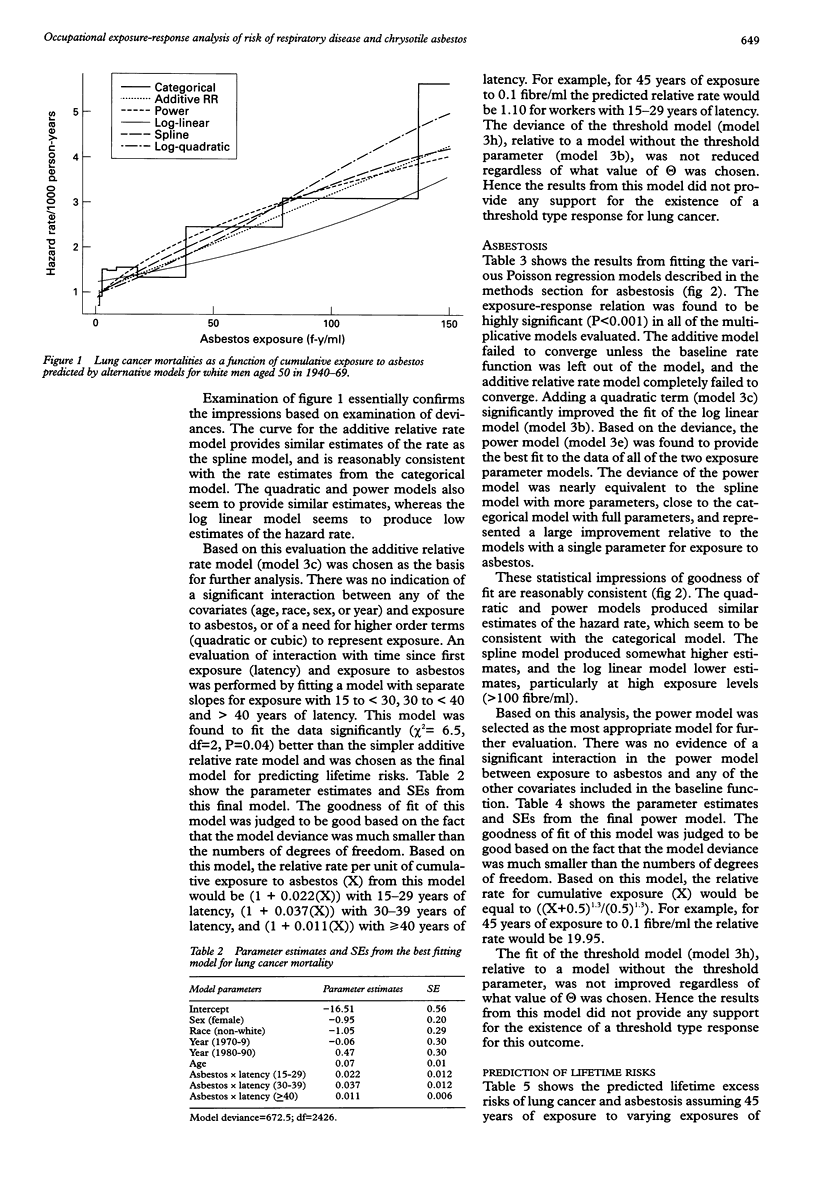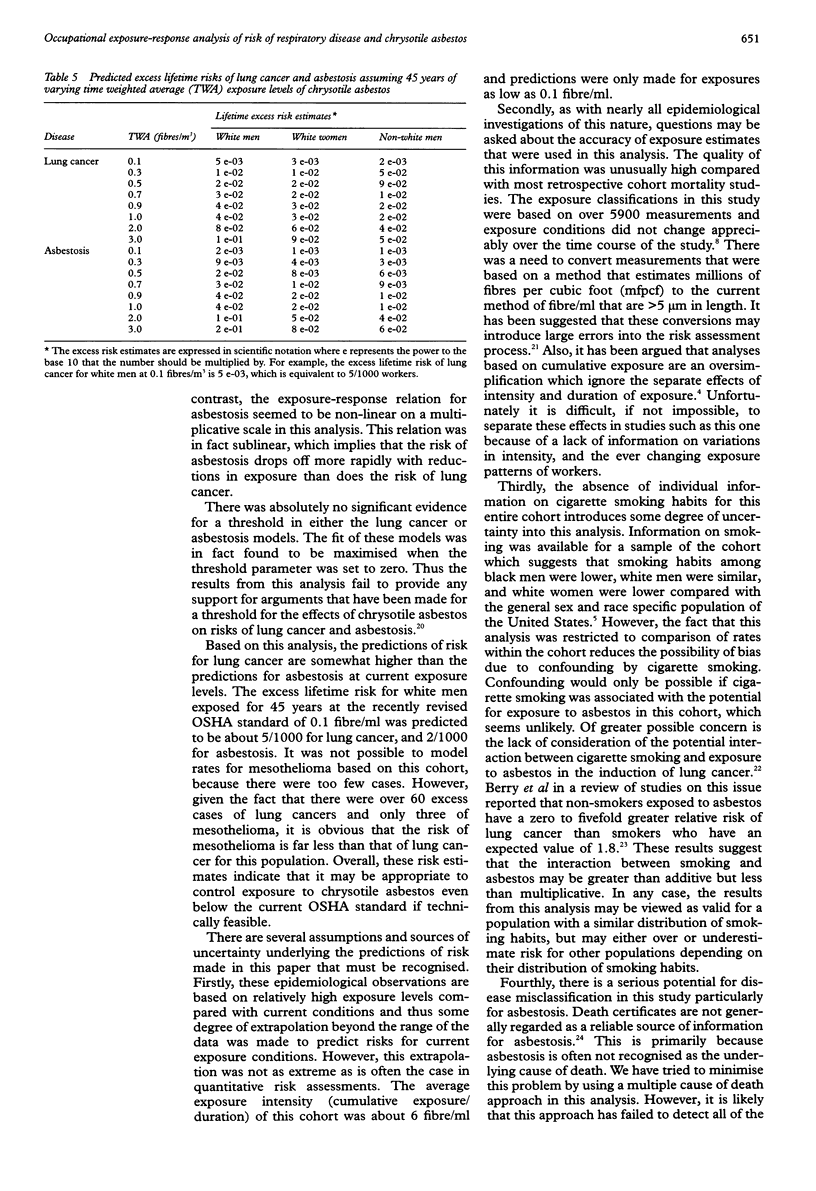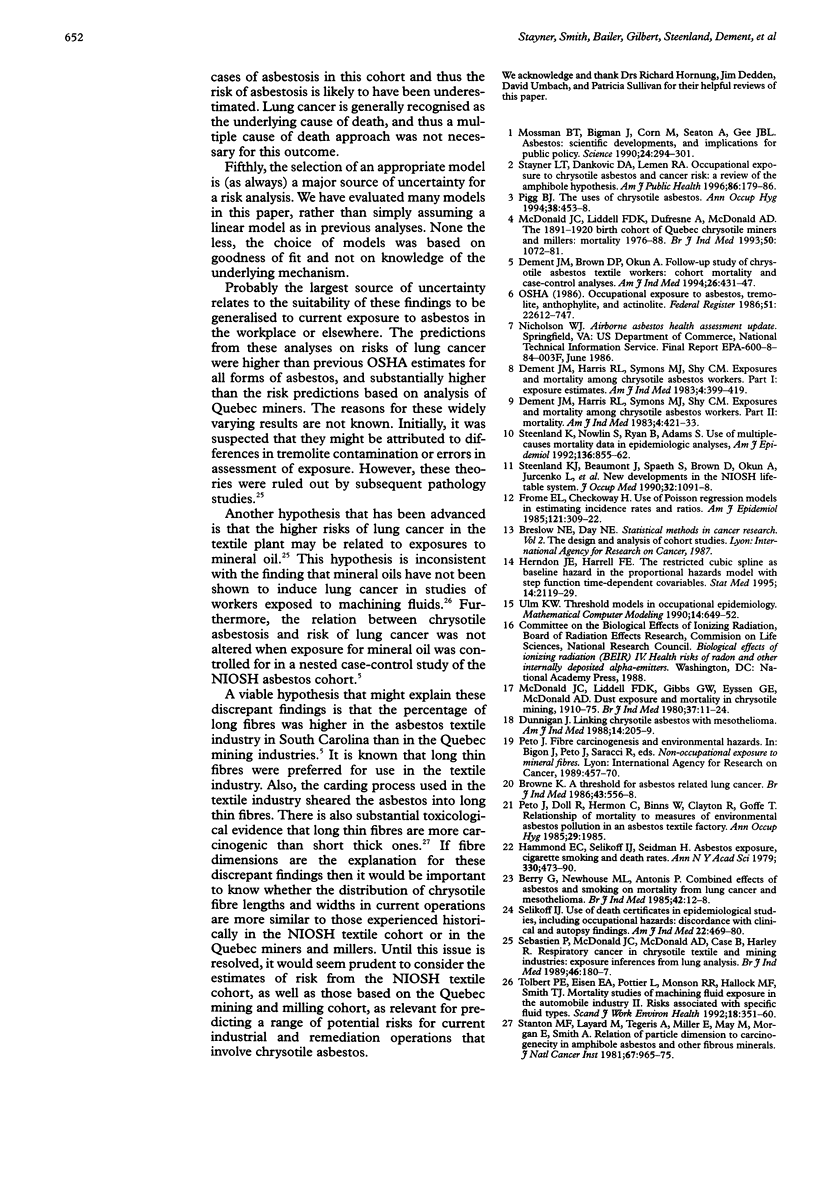Abstract
OBJECTIVES: To evaluate alternative models and estimate risk of mortality from lung cancer and asbestosis after occupational exposure to chrysotile asbestos. METHODS: Data were used from a recent update of a cohort mortality study of workers in a South Carolina textile factory. Alternative exposure-response models were evaluated with Poisson regression. A model designed to evaluate evidence of a threshold response was also fitted. Lifetime risks of lung cancer and asbestosis were estimated with an actuarial approach that accounts for competing causes of death. RESULTS: A highly significant exposure-response relation was found for both lung cancer and asbestosis. The exposure-response relation for lung cancer seemed to be linear on a multiplicative scale, which is consistent with previous analyses of lung cancer and exposure to asbestos. In contrast, the exposure-response relation for asbestosis seemed to be nonlinear on a multiplicative scale in this analysis. There was no significant evidence for a threshold in models of either the lung cancer or asbestosis. The excess lifetime risk for white men exposed for 45 years at the recently revised OSHA standard of 0.1 fibre/ml was predicted to be about 5/1000 for lung cancer, and 2/1000 for asbestosis. CONCLUSIONS: This study confirms the findings from previous investigations of a strong exposure-response relation between exposure to chrysotile asbestos and mortality from lung cancer, and asbestosis. The risk estimates for lung cancer derived from this analysis are higher than those derived from other populations exposed to chrysotile asbestos. Possible reasons for this discrepancy are discussed.
Full text
PDF






Selected References
These references are in PubMed. This may not be the complete list of references from this article.
- Berry G., Newhouse M. L., Antonis P. Combined effect of asbestos and smoking on mortality from lung cancer and mesothelioma in factory workers. Br J Ind Med. 1985 Jan;42(1):12–18. doi: 10.1136/oem.42.1.12. [DOI] [PMC free article] [PubMed] [Google Scholar]
- Browne K. A threshold for asbestos related lung cancer. Br J Ind Med. 1986 Aug;43(8):556–558. doi: 10.1136/oem.43.8.556. [DOI] [PMC free article] [PubMed] [Google Scholar]
- Dement J. M., Brown D. P., Okun A. Follow-up study of chrysotile asbestos textile workers: cohort mortality and case-control analyses. Am J Ind Med. 1994 Oct;26(4):431–447. doi: 10.1002/ajim.4700260402. [DOI] [PubMed] [Google Scholar]
- Dement J. M., Harris R. L., Jr, Symons M. J., Shy C. M. Exposures and mortality among chrysotile asbestos workers. Part I: exposure estimates. Am J Ind Med. 1983;4(3):399–419. doi: 10.1002/ajim.4700040303. [DOI] [PubMed] [Google Scholar]
- Dement J. M., Harris R. L., Jr, Symons M. J., Shy C. M. Exposures and mortality among chrysotile asbestos workers. Part II: mortality. Am J Ind Med. 1983;4(3):421–433. doi: 10.1002/ajim.4700040304. [DOI] [PubMed] [Google Scholar]
- Dunnigan J. Linking chrysotile asbestos with mesothelioma. Am J Ind Med. 1988;14(2):205–209. doi: 10.1002/ajim.4700140211. [DOI] [PubMed] [Google Scholar]
- Frome E. L., Checkoway H. Epidemiologic programs for computers and calculators. Use of Poisson regression models in estimating incidence rates and ratios. Am J Epidemiol. 1985 Feb;121(2):309–323. doi: 10.1093/oxfordjournals.aje.a114001. [DOI] [PubMed] [Google Scholar]
- Hammond E. C., Selikoff I. J., Seidman H. Asbestos exposure, cigarette smoking and death rates. Ann N Y Acad Sci. 1979;330:473–490. doi: 10.1111/j.1749-6632.1979.tb18749.x. [DOI] [PubMed] [Google Scholar]
- Herndon J. E., 2nd, Harrell F. E., Jr The restricted cubic spline as baseline hazard in the proportional hazards model with step function time-dependent covariables. Stat Med. 1995 Oct 15;14(19):2119–2129. doi: 10.1002/sim.4780141906. [DOI] [PubMed] [Google Scholar]
- McDonald J. C., Liddell F. D., Gibbs G. W., Eyssen G. E., McDonald A. D. Dust exposure and mortality in chrysotile mining, 1910-75. Br J Ind Med. 1980 Feb;37(1):11–24. doi: 10.1136/oem.37.1.11. [DOI] [PMC free article] [PubMed] [Google Scholar]
- Mossman B. T., Bignon J., Corn M., Seaton A., Gee J. B. Asbestos: scientific developments and implications for public policy. Science. 1990 Jan 19;247(4940):294–301. doi: 10.1126/science.2153315. [DOI] [PubMed] [Google Scholar]
- Pigg B. J. The uses of chrysotile. Ann Occup Hyg. 1994 Aug;38(4):453-8, 408. doi: 10.1093/annhyg/38.4.453. [DOI] [PubMed] [Google Scholar]
- Sebastien P., McDonald J. C., McDonald A. D., Case B., Harley R. Respiratory cancer in chrysotile textile and mining industries: exposure inferences from lung analysis. Br J Ind Med. 1989 Mar;46(3):180–187. doi: 10.1136/oem.46.3.180. [DOI] [PMC free article] [PubMed] [Google Scholar]
- Selikoff I. J. Use of death certificates in epidemiological studies, including occupational hazards: discordance with clinical and autopsy findings. Am J Ind Med. 1992;22(4):469–480. doi: 10.1002/ajim.4700220402. [DOI] [PubMed] [Google Scholar]
- Stanton M. F., Layard M., Tegeris A., Miller E., May M., Morgan E., Smith A. Relation of particle dimension to carcinogenicity in amphibole asbestoses and other fibrous minerals. J Natl Cancer Inst. 1981 Nov;67(5):965–975. [PubMed] [Google Scholar]
- Stayner L. T., Dankovic D. A., Lemen R. A. Occupational exposure to chrysotile asbestos and cancer risk: a review of the amphibole hypothesis. Am J Public Health. 1996 Feb;86(2):179–186. doi: 10.2105/ajph.86.2.179. [DOI] [PMC free article] [PubMed] [Google Scholar]
- Steenland K., Beaumont J., Spaeth S., Brown D., Okun A., Jurcenko L., Ryan B., Phillips S., Roscoe R., Stayner L. New developments in the Life Table Analysis System of the National Institute for Occupational Safety and Health. J Occup Med. 1990 Nov;32(11):1091–1098. doi: 10.1097/00043764-199011000-00008. [DOI] [PubMed] [Google Scholar]
- Steenland K., Nowlin S., Ryan B., Adams S. Use of multiple-cause mortality data in epidemiologic analyses: US rate and proportion files developed by the National Institute for Occupational Safety and Health and the National Cancer Institute. Am J Epidemiol. 1992 Oct 1;136(7):855–862. doi: 10.1093/aje/136.7.855. [DOI] [PubMed] [Google Scholar]
- Tolbert P. E., Eisen E. A., Pothier L. J., Monson R. R., Hallock M. F., Smith T. J. Mortality studies of machining-fluid exposure in the automobile industry. II. Risks associated with specific fluid types. Scand J Work Environ Health. 1992 Dec;18(6):351–360. doi: 10.5271/sjweh.1562. [DOI] [PubMed] [Google Scholar]


